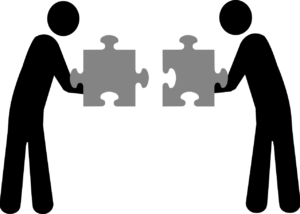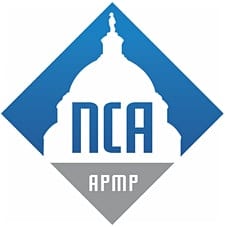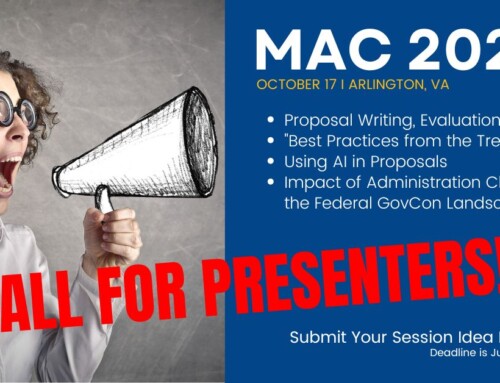This article is reprinted here with permission in collaboration with our corporate partner Xait. Visit Xait’s blog at https://www.xait.com/resources/blog
Five Tips for Collaborating Across Team Boundaries
Sales. Products. Services. Proposals. Team boundaries differentiate one workgroup from another, defining our common tasks and focusing on our shared objectives. When it comes to developing proposals, however, we are better when we work together. For proposal teams, who work across these boundaries every day, the key is collaboration. And knowing how best to collaborate across team boundaries.
#1 Team Collaboration (Horizontal)
Team collaboration, or the relationship between proposal team members, emphasizes equal participation. But “too many cooks” working on the same “sauce” can slow things down. Strengthen team collaboration by:

- Emphasizing relevance. Is it clear how one person’s task on project descriptions impacts another person’s task on resumes?
- Showing how tasks advance the organization’s goals. Is it clear how the team’s proposal process supports the organization’s business development goals?
- Holding each other accountable. Are we each following through on the work and deadlines we say we’ll do?
When the proposal team can see the big picture, and everyone knows where their pieces of the puzzle fit, work takes on new meaning, taking us to new heights of collaboration and productivity.
#2 Expert Collaboration (Vertical)
Expert collaboration, or the relationship between the proposal team and subject matter experts, emphasizes symbiosis. But experts have full-time jobs, work at odd hours, and are dubious of process. Strengthen expert collaboration by:
- Understanding and relating to colleagues on other teams. Are we taking time to “speak” a common proposal process language everyone can understand?
- Prioritizing tasks. When time is limited, can our experts see what proposal and task to prioritize?
- Emphasizing partnership. Do our experts trust the proposal team?
Focusing our proposal team’s energy on long-term relationships, rather than short turnarounds, goes a long way to building trust and inspiring collaboration with our experts.
#3 Stakeholder Collaboration (Executive)
Stakeholder collaboration, or the relationship between the proposal team and executives, emphasizes issue resolution. Executives are not typically involved in the proposal day-to-day, and that can lead to misunderstanding and doubt. Strengthen stakeholder collaboration by:
- Being direct. Does the executive understand how a slipped deadline puts the proposal at risk?
- Being precise about how the proposal team’s work aligns with their priorities and goals. Do executives understand how their reviews are a roadmap to greater proposal quality?
- Building a positive perception. Does the executive understand how the proposal process supports efficiency and winning proposals?
Understanding stakeholder needs and interests, and being prepared to address their concerns, will quickly demonstrate the proposal team’s value – including the benefits of collaborating with us.
#4 Demographic Collaboration (Diversity)
Demographic collaboration, or the relationship between people who absorb information differently, emphasizes communication. Not everyone has time to attend a stand-up meeting or the ability to absorb a lengthy process email. Strengthen demographic collaboration by:
- “Speaking” to different learners. Are we considering different types of learners when we craft our proposal communications?
- Providing communications that help people see (visuals), hear (discussions), get physical (note-taking), and read (minutes). Do our communications meet the needs of each learning style?
- Letting people absorb information at their own pace. Are we documenting meetings so people
can consult discussion and decisions on their own?
Taking time to accommodate how everyone absorbs information differently allows relationships to function, and inspires trust and more productive collaboration.
#5 Geographic Collaboration (Remote)
Geographic collaboration, or the relationship between people who work together at a physical distance, emphasizes visibility. Remote work may have come of age, but it can easily propagate delays that throw the proposal off schedule. Strengthen geographic collaboration by:
- Facilitating adhesion. Does the proposal team know what the experts and executives are working on today and vice versa?
- Introducing and connecting people to build bridges for the future. Are we designing a visible proposal experience so the “left” hand knows what the “right” hand is doing?
- Having conversations. Are we rushing to remind about deadlines, or are we engaging in meaningful conversations that promote understanding as well as the outcome?

As proposal professionals, one of our goals is to help others be successful. Making proposal work more visible empowers clarity and confidence and motivates greater collaboration. When our team boundaries intersect, our collective knowledge is greater than the sum of our parts. Our different points of view lead to better discussions that broaden our understanding and focus our energy. Strengthening collaboration across team boundaries encourages the problem-solving, productivity, and agility we need to align priorities, accelerate our goals and win.






Leave A Comment